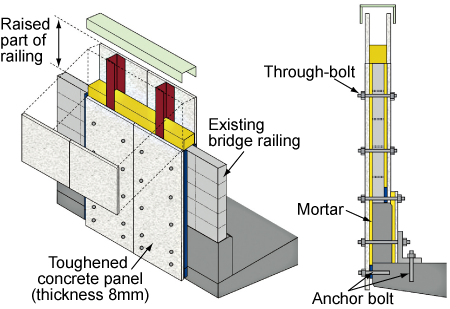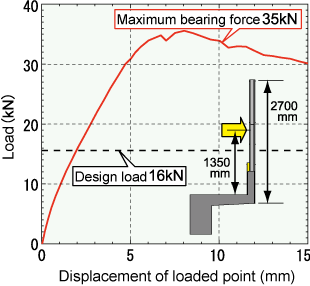2. Bridge railing reinforcement and repair method utilizing toughened cement board
- A method was developed to reinforce/repair dilapidated RC and block railings.
- Validation of the effectiveness of the reinforcement/repair was obtained during full scale field experiments, and a set of design / construction guidelines was compiled.
Ageing and weakening of RC (reinforced concrete) bridge railing and block railings has progressed over recent years, reducing the bearing capacity of these structures and giving rise to concrete spalling, and injury to third parties from falling concrete chips. Furthermore, in line with increasingly higher running speeds, and there are cases where better sound insulation by raising of the bridge railings will be needed. Consequently, in association with Obayashi Corporation, a reinforcement/repair construction method was designed through employment of toughened concrete panels. The method in question uses the toughened concrete panels to sandwich the existing bridge railing. The boards are then fixed into place with through-bolts, making it possible to restrain infiltration, which is one of the factors contributing to bridge railing weakening (Fig 1). Furthermore, the addition of connecting anchor bolts at the base of the panels is expected to improve the bearing capacity of the railings.
Previous methods consisted in the complete removal and subsequent replacement of bridge railings. The new approach however, means that work can be performed on the existing structure. As a result there is no more issue of removal and disposal of the bridge railings already in place, which saves time and expense. A further aim is to raise the structures by approximately 1 m.
The present repair/reinforcement method was validated from number of different perspectives, namely: standalone performance of the toughened concrete panel, and performance when associated with existing bridge railings, the joining structure to work with a series of toughened concrete boards, and the influence of weakening in the bond between several toughened concrete sheet and the existing bridge railing under the effect of age related degradation. For example, in the case of bearing capacity performance with consolidation, in comparison to the bearing capacity of a structure designed to withstand a wind speed of 50m/s, the maximum bearing force was confirmed as being almost double (Fig 2). The outcome of the above work served as a basis to compile a set of “guidelines for work and design of repair work on railway bridge railings, etc., using toughened cement boards”.
 Fig. 1 outline of the present work method
Fig. 1 outline of the present work method Fig. 2 Verification of reinforcement effectiveness
Fig. 2 Verification of reinforcement effectiveness